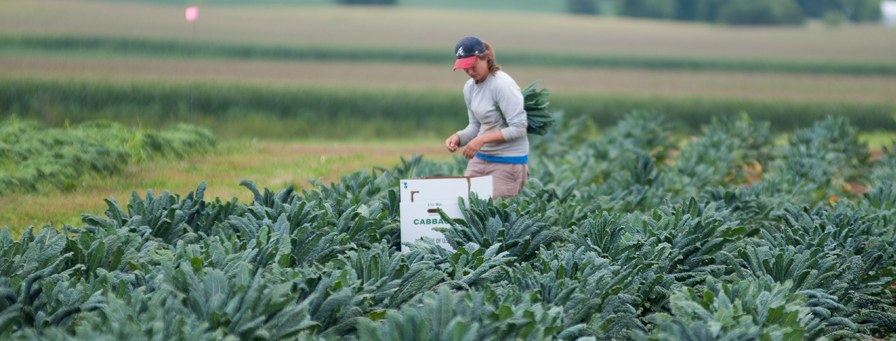




Organic is an opportunity
Since 1990, the organic food industry has grown by over 20% per year. The conventional food industry has averaged 3% growth during this same time period. In 2020, organic sales reached $61.9 billion dollars and now represents 6% of all food sold in the United States. Nearly all retailers report that consumers are demanding even more organic options. The market continues to grow at a rapid pace, so more organic farms and processors are needed to meet this demand. The future is very bright for organic food production.
Consumers are willing to pay a premium price for organic foods. A recent analysis shows that organic foods sell for 20% to 60% higher prices than conventional foods. This price premium helps with greater economic returns for organic farmers and processors.
Before you begin your transition to organic, be sure to research your market options. Contact organic buyers and processors in your area to determine the need and the potential market. You should approach organic production like any other business enterprise. Good research and planning will help you make sound decisions.
Now is a great time to go organic, and MOSA is here to help you make the transition. We are happy to help with any questions you have prior to and during your transition. It is our goal to ensure that you understand the rules, and the process, so your transition is as smooth as possible. MOSA is your partner in organic success.

Making the Transition – Food Processors and Handlers
Food processors, restaurants, distributors, and retailers do not have a required transition period if they are not growing their own food or fiber (purchasing all inputs). If you do have your own production, that land and/or those animals will have to follow the same transition requirements listed below.
Making the Transition – Land
Once you decide to “go organic,” you need to understand the process of transition. The years prior to organic certification require careful attention. In most cases, it will be necessary to manage a farm by the National Organic Standards for a period of time while the land and/or animals transition to a certfiable status. The official rule is that land has to be managed without prohibited inputs for 36 months before that land can be used for certified organic production.
Land that is currently being farmed with chemical fertilizers and pesticides will likely have to undergo a full three year transition. If the land has never been farmed, or it has been some time since the last application of a prohibited material, it may immediately qualify, or take a shorter period of time to transition. To determine how long each field will take, simply determine the last date a prohibited material was applied, and then move forward 36 months. That is the date when that field will be certifiable. It is common to have fields with different transition times.
For example, a farm has ten fields. Four have been in hay for three years and have had no inputs during that time. Those four fields would be immediately certifiable. The remaining fields have been in a corn and soybeans rotation. Each of these fields was fertilized with synthetic fertilizer at planting and then sprayed for weeds in June. These fields will need to transition for 36 months from that last application of herbicide.
It is also important to note, that a crop can be planted prior to the end of transition, and harvested after that date as an organic crop. In the example above, even though crops will be planted in the spring just prior to the transition date in 36 months (June), as long as the crops are harvested after that date, they can be certified organic.
Because the certification process can take up to three months to complete, it is important to submit your application materials well in advance of your harvest dates. You do not need to wait until your transition is complete to begin the process. We will work with you to ensure your timing needs are met, but it is up to you to submit the required paperwork in advance of your first planned organic sale. New applications can be accepted at any time.
PROHIBITED MATERIALS
During the transition, you need to manage that land as if it were organic. That means that only materials that are listed as approved can be used. If a prohibited material is applied intentionally, or by accident, your transition date for that field will be reset to 36 months. It is critical to understand and follow the National Organic Standards during the transition period to prevent costly mistakes. We strongly recommend that you contact us for a copy of the National Organic Standards and for a copy of the National List of Approved and Prohibited Substances. In addition, you will find many pertinent details by visiting our Education & Resources pages.
In general, all synthetic inputs are prohibited. This includes chemical fertilizers and pesticides. There are also a few natural inputs that are prohibited due to toxicity or other negative impacts. Reference the National List and the OMRI Materials List for details, or call MOSA. Never apply an input when you are not sure of the status. Also note that all genetically-modified seeds, and products made with genetically-modified ingredients are prohibited.
Special Note: Manure from conventional farms is not a prohibited input, provided it has not been treated with, or mixed with, prohibited materials.
SEEDS
One notable difference between the transition years and certified organic production is the use of certified organic seeds. The National Organic Standards require certified operations to use certified organic seeds. Farms in transition do not have to use certified organic seeds, but any seeds used must be non-GMO and untreated. Like with prohibited materials, GMO or treated seeds will reset your transition time to 36 months. If you plant a crop during the transition, but intend to harvest that crop as organic, those seeds must be certified organic.
Making the Transition — Livestock
Some animals can be transitioned into organic production and some cannot.
MILK ANIMALS
Dairy animals can be transitioned to organic production. The official rule is one year of organic management before their products can be certified organic. During that year, the animals must be fed 100% organic feed and must be managed without prohibited materials. Antibiotics, hormones and most synthetic health inputs are prohibited during this one year transition.
Fortunately, there is a rule that allows for ruminant livestock to transition with the third year of transition crops. In other words, rather than a total of four years of transition (three years for the land and one year for the herd) the herd transitions with the final year of crop production. Third year transitional feed must come from your own farm and cannot be purchased during that third year. Any purchased feed must be certified organic during the herd’s transitional year.
MEAT & FIBER ANIMALS
Mammalian animals must be raised organically from at least the last third of gestation. During that time the mothers must be fed 100% certified organic feed and managed without prohibited materials. The mothers do not have to be from organic stock, but can never be sold for organic meat.
Poultry must be raised organically from the 2nd day of life to be sold as organic.
PASTURE AND OUTDOOR ACCESS
Under the National Organic Standards, all ruminant animals are required to have a minimum of 30% Dry Matter Intake (DMI) from pasture for a minimum of 120 days during the grazing season.
Dairy animals must be under continuous organic management for a minimum of 12 months immediately prior to production of milk or milk products that are to be sold, labeled, or represented as organic. This includes a ration of 30% DMI intake from organically managed pasture. You must demonstrate adequate pasture during your first application and inspection. If you do not currently have enough pasture to meet the rule, you should begin converting some fields to pasture, fencing new pastures, and researching rotational grazing systems if you are not already using this system.
Outdoor access is required, weather permitting, for all organic livestock.
The single best resource about the transition and certification process is the MOSES Guidebook for Certification, which is available on our Certification pages, or by visiting the MOSES website.
MOSA’S TRANSITIONAL VERIFICATION
To make your transition to organic certification easier, you may want to take advantage of MOSA’s Transitional Verification Program. For $300 per year, we will review your records and paperwork to verify that your inputs, seeds, and recordkeeping are compliant with the National Organic Standards. After our internal review, you will receive a Transitional Verification Letter that will outline areas of compliance and noncompliance, and will confirm the transition completion dates for your farm fields. This annual process will give you peace of mind and a better understanding of the recordkeeping requirements you must keep and submit when you request certification for the first time. No on-farm inspection is required during Transitional Verification; only an office review, which keeps your costs down. In addition, you’ll get ongoing support from our Certification Customer Service Team, who can help with input approvals, and provide assistance to keep you on the right track. Contact MOSA to get started!

